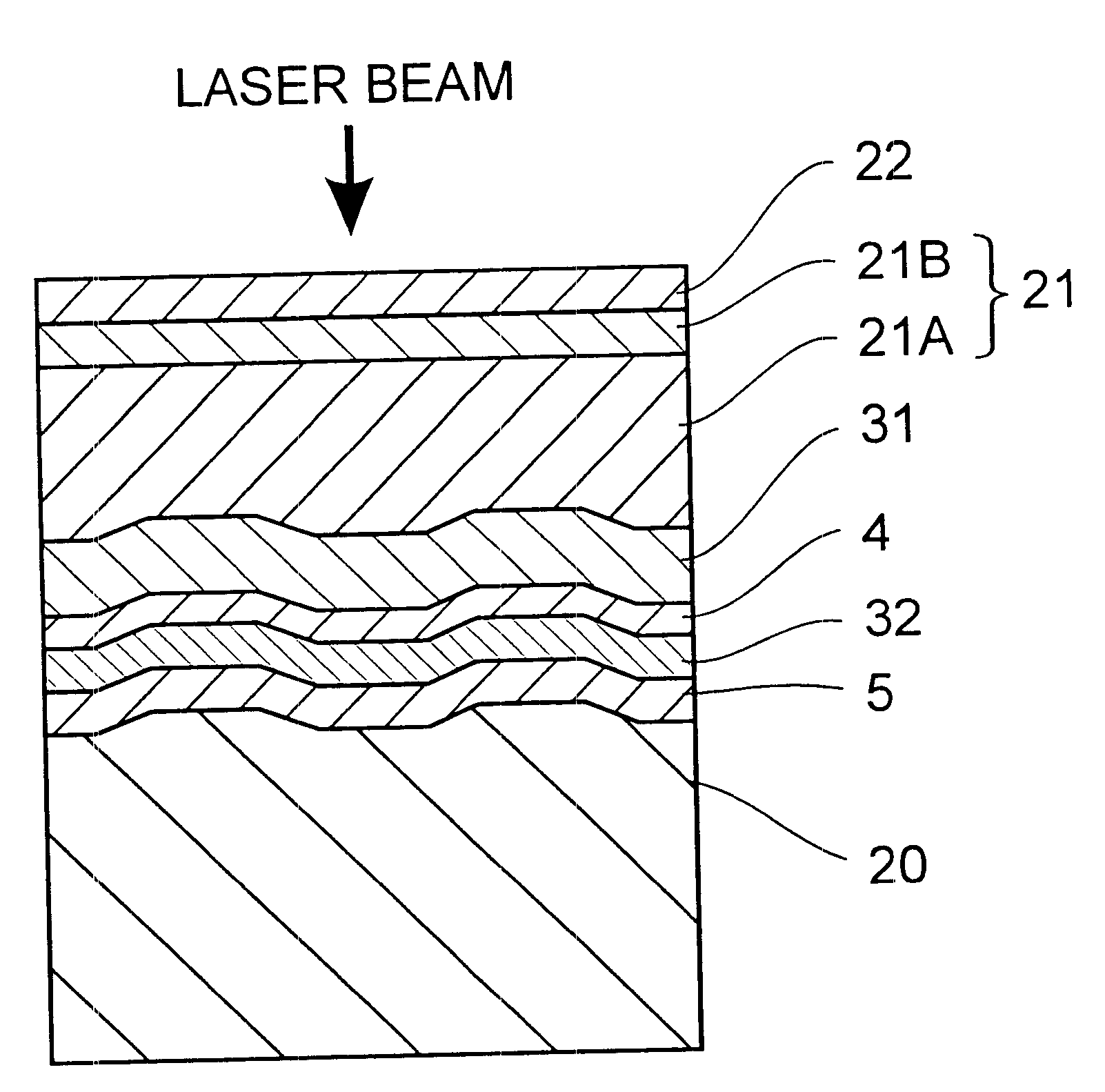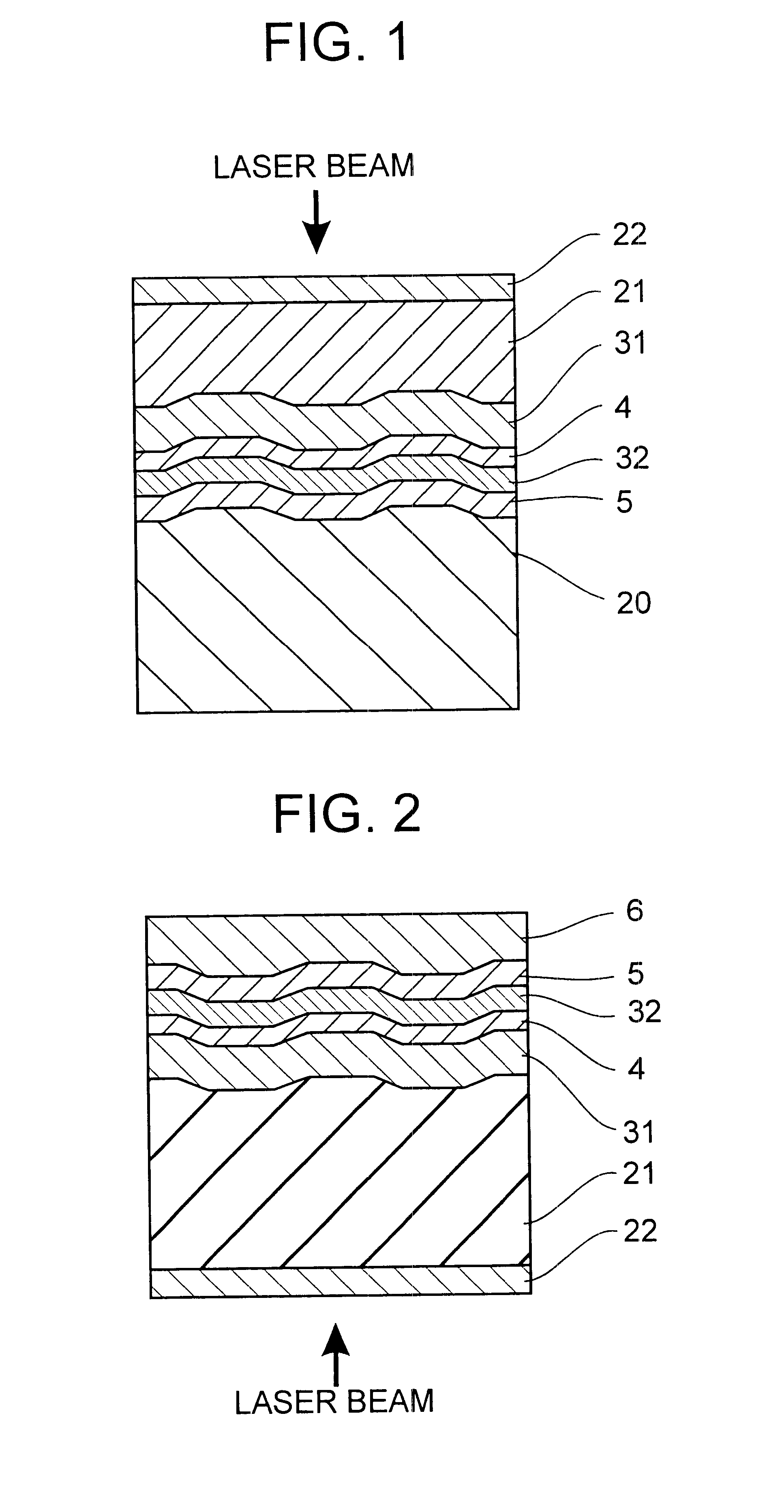Optical information medium and evaluation method
a technology of optical information and information layer, applied in the field of optical information media, can solve the problems of reducing the tolerance for the tilt of the information recording layer of the medium, establishing such a recording/reading system, and reducing the focal depth, so as to mar resistance, and improve the abrasion resistance.
- Summary
- Abstract
- Description
- Claims
- Application Information
AI Technical Summary
Benefits of technology
Problems solved by technology
Method used
Image
Examples
example 1
Inverse Laminate Type
Medium 1
Medium 1 having the same structure as FIG. 1 except that it was of the read only type was fabricated by the following procedure.
First, a polycarbonate substrate (outer diameter 120 mm, thickness 1.2 mm) in the surface of which random signal data were previously formed as prepits was used as a supporting substrate 20. On the surface of the supporting substrate 20 where prepits were formed, a reflective layer of aluminum was deposited to a thickness of 100 nm by a sputtering technique. Then a coating of UV-curable resin (SD301 by Dainippon Ink & Chemicals, Inc.) was applied to a thickness of 100 .mu.m by a spin coating technique and cured with UV radiation to form a light-transparent substrate 21. It is noted that when the light-transparent substrate 21 after curing was peeled from the reflective layer and measured for tensile modulus, it had a tensile modulus of 970 MPa.
Next, on the light-transparent substrate 21, a xylene solution of inorganic polysilaza...
example 2
Medium 4
A commercially available DVD-RAM (recording capacity 2.6 GB / side) was furnished. DVD-RAM is a phase change recording medium and has substantially the same structure as the medium shown in FIG. 2, two of which are joined together with the protective layers 6 abutted. The recording layer 4 is composed mainly of Ge, Sb and Te and the light-transparent substrate 21 was a polycarbonate substrate of 0.6 mm thick.
Using this DVD-RAM, Medium 4 having the structure shown in FIG. 4 was fabricated by the following procedure. With the polycarbonate substrate of DVD-RAM being regarded substrate body 21A, a UV-curable acrylic resin (HOD-3200 by Nippon Kayaku Co., Ltd.) was applied on its laser beam incident side surface by a spin coating technique and cured by irradiating UV radiation (high-pressure mercury lamp, dose 300 mJ / cm.sup.2), forming a barrier layer 21B of 3.3 .mu.m thick. The light-transparent substrate 21 had a tensile modulus of 1,340 MPa.
Subsequently, a cured polysilazane fil...
example 3
Medium 7
Medium 7 having the same structure as FIG. 6 except that it was of the read only type was fabricated by the following procedure.
First, a polycarbonate substrate (outer diameter 120 mm, thickness 0.6 mm) in the surface of which random signal data were previously formed as prepits was used as a substrate body 21A. On the surface of the substrate body 21A remote from the prepitted surface, a barrier layer 21B was formed as in Medium 4. The light-transparent substrate 21 had a tensile modulus of 1,340 MPa. Subsequently a cured polysilazane film 22 was formed on the surface of the barrier layer 21B as in Medium 1.
On the prepitted surface of the substrate, a reflective layer of aluminum (100 nm thick) was deposited by a sputtering technique. Then a prepit-free polycarbonate substrate (outer diameter 120 mm, thickness 0.6 mm) was joined to the surface of the reflective layer with a UV-curable adhesive (acrylic, adhesive layer after curing had a thickness of 5.0 .mu.m), completing a...
PUM
| Property | Measurement | Unit |
|---|---|---|
| thick | aaaaa | aaaaa |
| thickness | aaaaa | aaaaa |
| thickness | aaaaa | aaaaa |
Abstract
Description
Claims
Application Information
 Login to View More
Login to View More - R&D
- Intellectual Property
- Life Sciences
- Materials
- Tech Scout
- Unparalleled Data Quality
- Higher Quality Content
- 60% Fewer Hallucinations
Browse by: Latest US Patents, China's latest patents, Technical Efficacy Thesaurus, Application Domain, Technology Topic, Popular Technical Reports.
© 2025 PatSnap. All rights reserved.Legal|Privacy policy|Modern Slavery Act Transparency Statement|Sitemap|About US| Contact US: help@patsnap.com



